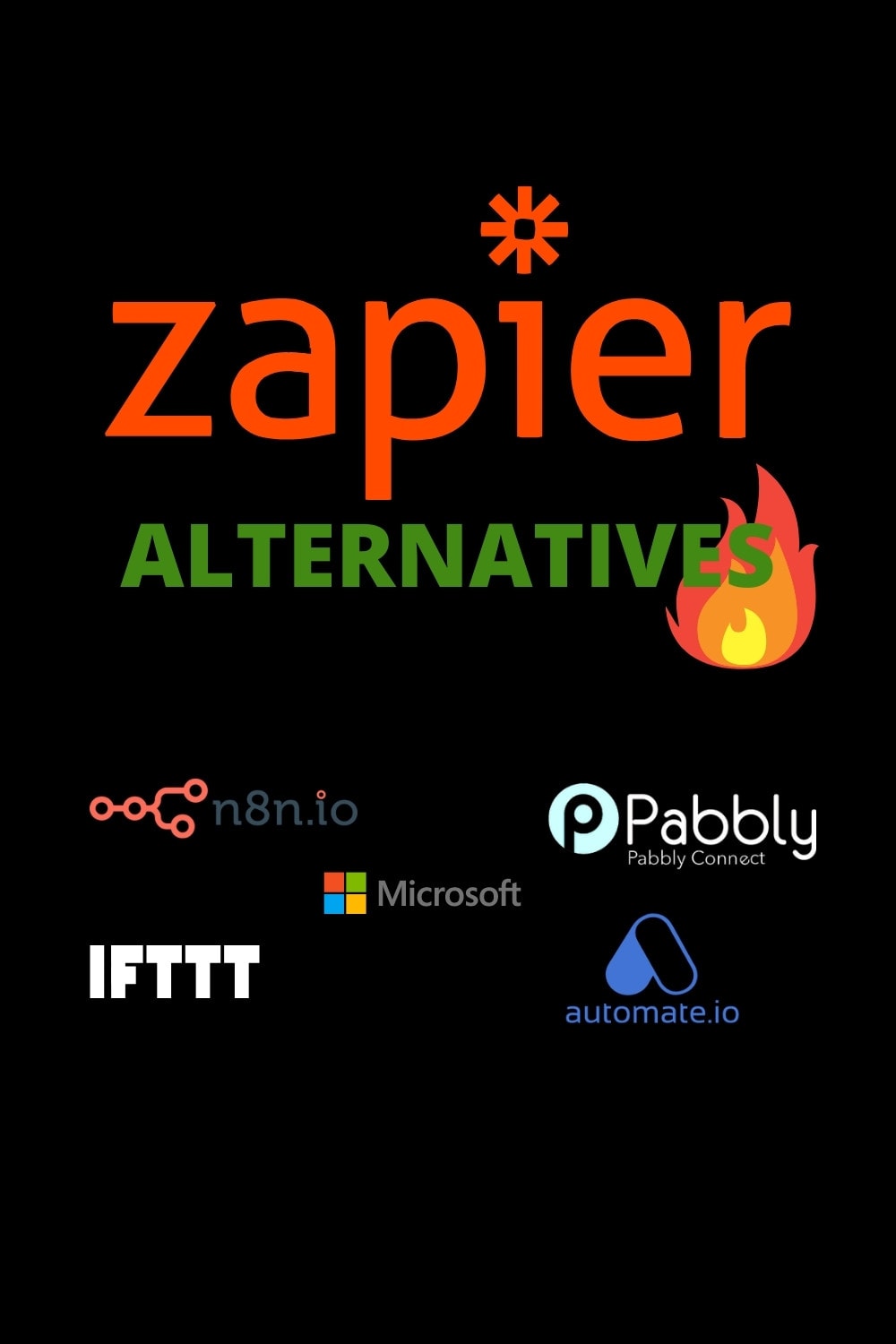Is there an alternative to Zapier worthy of your time and money? Let's find out!
Zapier is a powerful business process automation platform that lets you automate repetitive tasks like scheduling events, adding email addresses to your email marketing contacts, sending reminders, adding Google Ads leads to a Google sheet, triggering Zaps with Airtable rows, or simply adding tasks to your to-do list. Best of all, it requires no coding experience.
However, Zapier not the only software with automation capabilities. There are cheaper, easier-to-use, and faster alternatives to Zapier to choose from. Each Zapier competitor has its own pros and cons. Using this guide, we'll help you determine the best Zapier alternatives that will save you time and money.
Let’s get started.
Comparison Table
| Tool | Number of Apps | Pricing |
| n8n | 200 | Free, €20, €50, €120 |
| Albato | 500 | Free, $15, $42, $104, $162, custom |
| Pabbly Connect | 700 | Free, $9, $15, $29 |
| Bit Integrations | 70 | $19 per year |
| Uncanny Automator | 26 (WordPress) & others | $195 per year |
| WP Fusion | 102 plugins (WordPress), 50+ CRMs | $247 per year |
| Thrive Automator | Dozens | Free |
| WP Webhooks | Dozens | $149 per year |
| Make | 1300 | Free, $9, $16, $29 |
| Power Automate | 500 | $15, $40, $500 |
| IFTTT | 300 | Free, $3, $199, custom |
Make
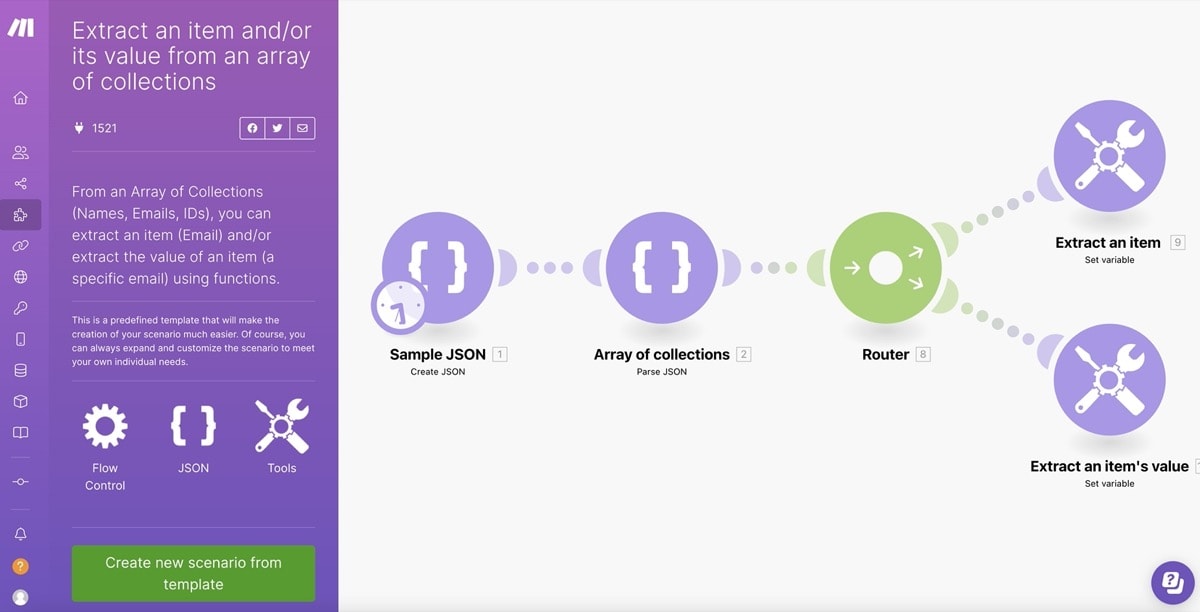
With its intuitive user-friendly interface and high level of functionality, Make (formerly Integromat) may be the most capable tool on this list. The advanced features are incredibly powerful, at least once you get use to the workflow. While the setup process is a bit more complicated, it is also more efficient than Zapier's workflow overall. Throughout your process, Make shows you exactly what's happening. And there's a level of granulairty that you just don't get with Zapier.
You can get right down into the nuts and bolts of any automation with Make. It's highly customizable and lets you tinker much more than Zapier, which has a more closed ecosystem. Make is perfect for more complex tasks or those that require customization.
Create automations with Make by combining “modules” with “functions” using Make's visual drag-and-drop functionality. Modules are like bubbles that represent each step of your automation, such as actions, searches, triggers, conditional flows, and iterators. Functions are used to make your automation more powerful—you can use them to create automated workflows to work with text, dates, or numbers, or even filter data or configure a multi-step scenario!
Flows are called scenarios and app connectors are simply called “connections”. You've even got webhooks and data stores to really go all-in with your automation. You can create some seriously complex workflows by combining Make's built in apps like the iterator, router, or json data arrays. Use custom and pre-build connectors to connect almost any webservice to a cloud integration or app.
Make is a cheaper alternative to Zapier (there's a free version) yet it's also more powerful and more configurable. The visual interface makes more sense than the table flow style of Zapier. While Zapier has around three times as many integrations as Make, if you don't use everything on the list, then there's no advantage. Determine what you need (and what you might need in the future before deciding).
Albato
Albato is a nocode workflow application let's you connect software tools and services to improve efficiency and build larger applications. So far, that's similar to other tools on the list.
First of all there's price. Albato works out to be much cheaper than Zapier. Then there's support, which is responsive and fast. Live chat is on the way.
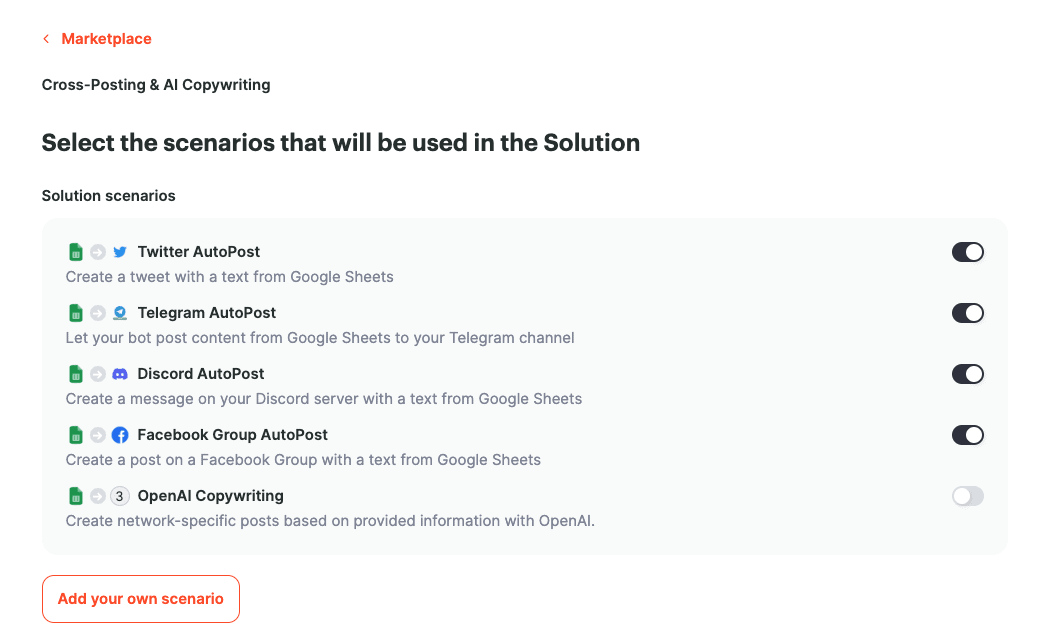
The interface is attractive and welcoming. This is important if you're going to spend a lot of time in there. For simpler automations, you won't need to spend a lot of time looking at the interface. But if you want more complicated processes, it's nice that the interface isn't too hard on the eyes.
The 3 Step Workflow Automation is a nice touch and makes things much smoother, even for novices (to a point – see later)
Connect more than just a few apps; build SaaS ecosystems across dozens of apps and platforms. And if you can't find the app, you can add it yourself. That's one of the biggest differentiating factors in my opinion.
Albato also offers an iPaaS (integration platform as a service) service, which allows SaaS tools businesses to build automation worklows and integrate with the cloud.
Albato has many tiers or pricing including custom pricing for high volume businesses. There's also a free plan.
What's good?
- Albato's user-friendly design, the ability to add applications that offer public APIs (unlike Zapier), as well its growing list of supported applications (among other things) make it a versatile tool.
- Responsive customer service, affordability, and intuitive design make Albato a worthy opponent even to big players like Zapier.
- The conditional logic system allows you to create complex automations that can handle a wide variety of scenarios.
What's not so good?
- Its most powerful asset is also its biggest weakness: The steep learning curve for those not well-acquainted with technical environments. Ont the other hand, the website contains many instructional videos and text tutorials to help you get started.
- Albato’s lack of pre-built automation templates is another shortcoming
n8n
n8n.io comes with a fair-code license allowing you to use it for both personal and corporate purposes. However, the automation platform is only free when it is self-hosted, meaning you'll need to run the software on your own web server or hosting platform. That being said, n8n emerges as the top open source alternative to Zapier, offering a powerful and flexible automation platform without the constraints of proprietary software.
If you decide to sign up for n8n.io's cloud applications platform, where everything is hosted for you, you’ll be charged according to the tool’s pricing structure. The Start plan costs €20/month for 5,000 executions/month, while the Pro and Power plans cost €50 for 15,000 executions/month and €120 for 60,000 executions/month, respectively.
Compare this with Zapier which charges around $80 for 5,000 tasks.
n8n is also extendable, meaning that you can create custom nodes and seamlessly integrate third‑party in-house apps and connect marketing automation software in the same workflow.
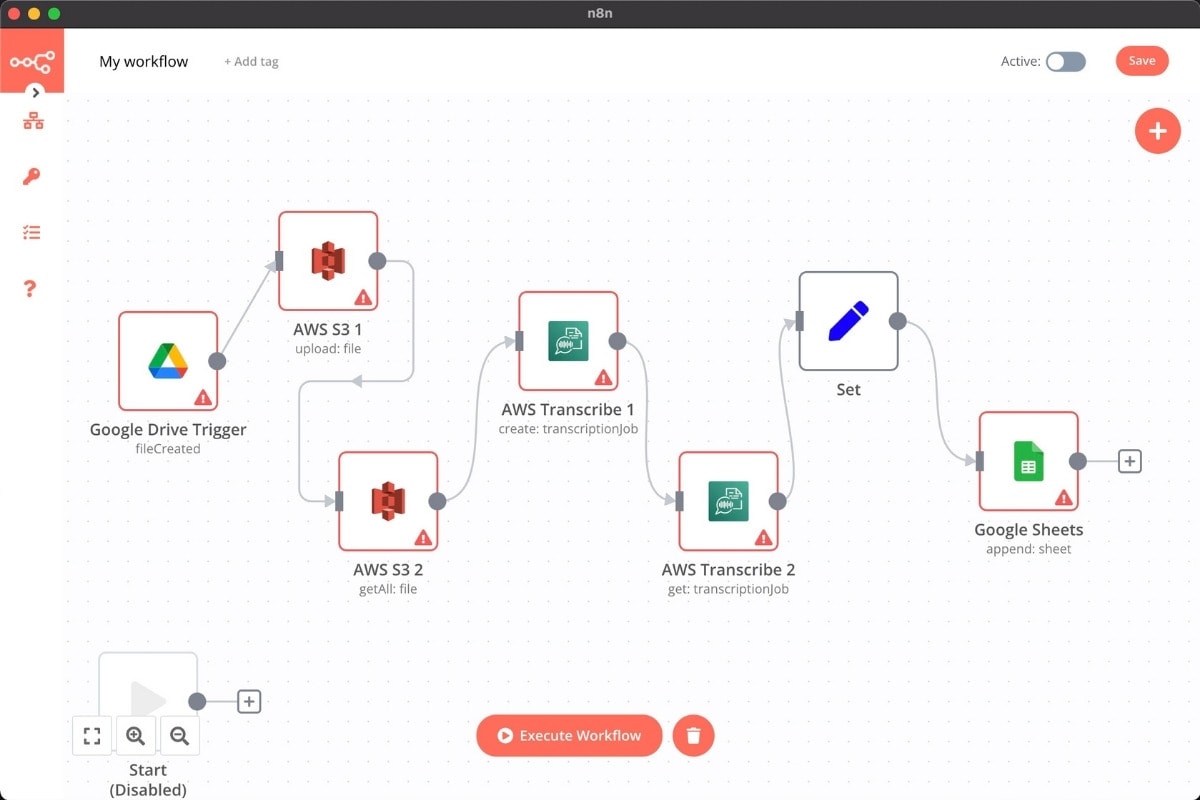
You've got the best of both worlds: run the automation app locally for free or keep the hub of your operations in the cloud for a great price. You also get full control over who can access the data. But that's not all. There's also a desktop app that you can use to test out the software or run local and internal business processes too.
n8n.io is capable of automating workflows across over 200 of the most popular web apps like ClickUp, Dropbox, ConvertKit, Facebook Ads, Google Analytics, and Hubspot CRM and operations hub, ensuring that your repetitive and routine tasks are a thing of the past.
All in all, n8n.io makes an excellent alternative to Zapier for those who prefer self-hosting and the pricing is attractive to people looking for a cheaper business process automation tool. It is a very popular marketing automation tool for both technical marketers and No Code entrepreneurs, and earned #1 Product Of The Week award on ProductHunt.
For security-conscious users, n8n scores highly in independent security reviews, achieving 83/100 in terms of maintenance and risk from developer security platform Snyk.
Keep in mind that the number of apps is small (but growing) so it's worth checking the full list to see if your workflow requirements can be met.
I found n8n to be one of the most enjoyable apps to create workflows with and one of the most flexible too. For more complex multi-step and multi-app workflows, n8n is much better than Zapier. I would love to see more apps integrated though.
Try n8n.io
Pros ✅
- Self-hosting option with fair-code license
- Importing workflows is as easy as copy-pasting text
- Extendable workflow with custom nodes – develop your own custom workflows and custom integrations.
- Multi-triggering – multiple node triggers are a feature unique to n8n and allow for super powerful automations.
- Excellent customer data privacy (data stored in the EU) & security
- Highly-rated support and excellent customer service
- Great for solo business owners who want to save money and have flexibility in their automations
Cons ❌
- Has a bit of a learning curve.
- Has less than 10% of the app integrations offered by Zapier
Pabbly Connect
Pabbly is an intuitive yet powerful tool for people looking to save time and automate their repetitive tasks. It has a drag-and-drop interface that is so easy to use, that you’ll be up and running in minutes. Pabbly is a perfect task automation solution for freelancers and small agencies who might be working in teams or with clients around the world.
But larger organizations with non-technical sales and marketing teams, human resources teams, business teams, and marketing departments can also harness the power of Pabbly.
If you are always looking to improve your productivity, this app is definitely something to look into!
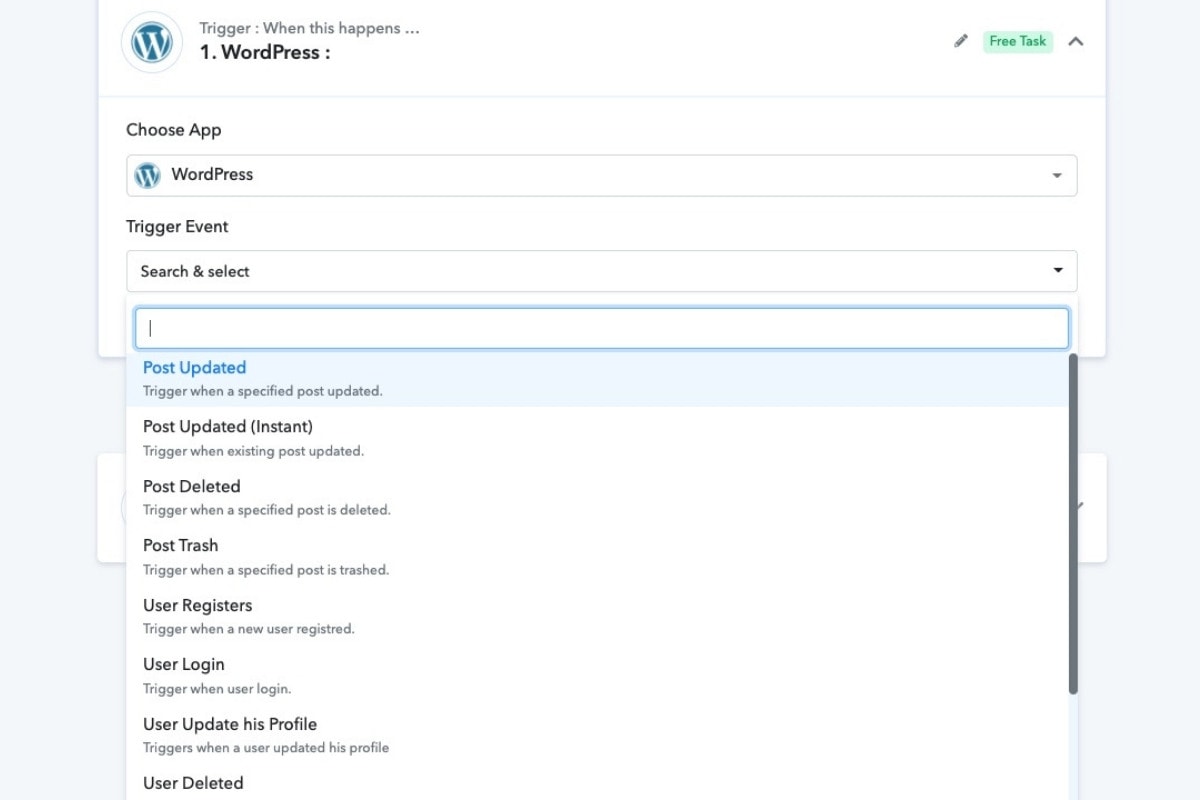
Pabbly's user interface is a breeze to work with. There are several notable features in this tool that will make your work easier. For example, the drag-and-drop option which lets you drag and drop different apps so that they interconnect seamlessly. Just drag and drop the icons of two services you want to connect on Pabbly's dashboard and you're all set.
Setting up a marketing workflow is also easy thanks to the intuitive step-by-step procedures, not to mention the comprehensive support including over 1000 video tutorials.
Plus, if your app or service doesn't yet have native integration, you can connect via webhook or access Pabbly's API (for the techies). Getting started with Pabbly Connect is simple.
This worthy alternative to Zapier offers unlimited workflows, multi-step calls, path routers, instant triggers, and many more. Automate text extraction, date/time formatting, math operations, and encryption/decryption. Plus, you can easily customize the frequency by which the workflow gets executed. You can also set delay and advance workflows.
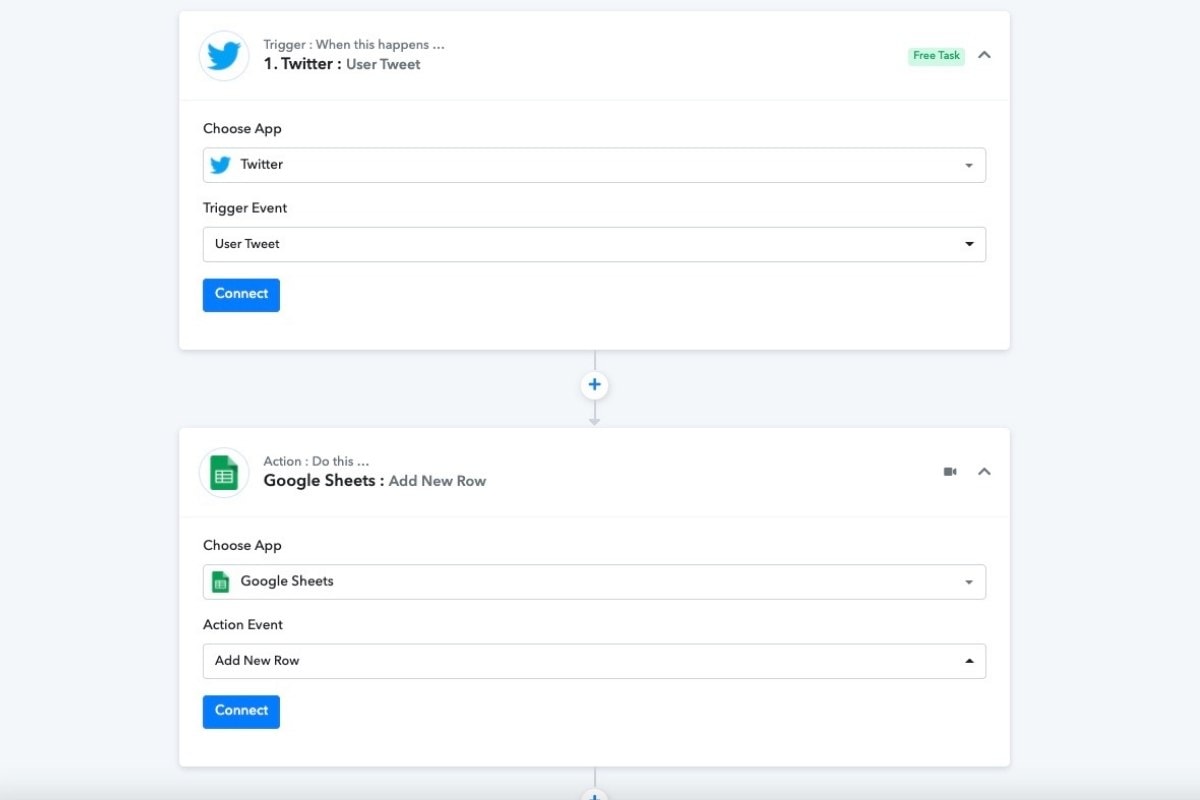
Connect Google sheets with Facebook Ads, ConvertKit with WooCommerce, ThriveCart with Aweber, the possibilities are endless
The free plan is generous, offering unlimited operations, unlimited workflows, and 100 tasks per month
Pabbly Connect has one of the easiest-to-use and best-looking interfaces. The user interface and user experience are better than any other tool in this list of Zapier alternatives.
Only actions count as tasks – that’s how its pricing is structured. Internal tasks are free. Pricing for the Starter plan is $9/month for 12,000 tasks, while the Rookie plan's pricing is $15/month for 50,000 tasks. As for the Advanced plan, you get up to 80,000 tasks at just $29 per month.
On top of that, you get a free plan that limits the number of tasks to just 100 each month. Oh, and if you opt for a 12-month, 24-month, or 36-month payment plan, you become eligible for significant discounts.
Try Pabbly Connect
Pros ✅
- 700+ integrations including Google Sheets, Facebook Lead Ads, Linkedin, Stripe, and WordPress
- Simple and intuitive interface 👍
- Unlimited workflows
- Does not charge per “trigger” or internal steps. One task is one task (unlike Zapier)
- Supports workflow scheduling
- Clear and affordable pricing
- Generous free plan that beats Zapier's free plan by a mile
- 1000+ Video Tutorials to help you connect hundreds of apps together
Cons ❌
- Limited triggers
- A few privacy concerns in the past have slightly marred the company's reputation.
Uncanny Automator
If you're looking for a tool with advanced features that work directly inside your WordPress website, look no further than Uncanny Automator.
The biggest key difference between this tool and most of the others in this list of automation services is that Uncanny Automator runs inside WordPress and connects plugins together (and to external sites and apps). Most of the other tools, including Zapier, are cloud applications, managed and hosted by a third party.
The Automator plugin integrates with 26 WordPress plugins (some of which support dozens of triggers and actions). Zapier, for example, works with 11 WordPress plugins. Both solutions offer many triggers, but Automator has native access to WordPress APIs, hooks, and functions, so it can accomplish things Zapier cannot.
With Automator's free plugin, you can also create multi-step recipes by using multiple triggers in one recipe (Zapier doesn't offer this feature).
Create connections between popular WordPress plugins like WooCommerce, Ninja Forms, LearnDash, Elementor Pro, and Affiliate WP to build data-driven automated workflows.
Prices start at $149 per year for unlimited recipes and no transaction fees. You get a no-code visual editor for multi-step workflows that non-technical users will love.
Pros ✅
- Easy for Non-technical WordPress users to use
- Multiple triggers in one recipe
- Unlimited recipes
- Direct access to WordPress APIs and hooks
- For heavy users, this solution is extremely affordable, since there is no limit to how many app integrations or recipes one can use.
Cons ❌
- WordPress only
- Slow development cycle so new integrations can take a while
WP Fusion
The majority of people reading this article will be WordPress users. For those of you who need a CRM integrated with your WordPress website (for instance), WP Fusion is the perfect solution.
If you're a course owner and community administrator using a tool like Learndash, or you have a sophisticated email marketing and CRM platform like Brevo, there's simply nothing to compare to the power that WP Fusion offers.
There is simply no comparison between the WP Fusion plugin and Zapier when it comes to integrating WordPress seamlessly. Using WP Fusion, you can take advantage of all the benefits of deep native integrations with the WordPress ecosystem.
SaaS platform Zapier integrates with some WordPress functions and plugins but WP Fusion provides greater functionality since data is directly sent to the connected tool. In contrast, Zapier uses its own cloud platform to send data (for many business owners, this is a security risk).
Let's imagine you want to get a bigger picture of what your website users are doing. Hubspot CRM is one of the world's most popular customer relationship databases and can be deeply integrated with WordPress using the WP Fusion plugin. It's one of the best solutions for integrating WordPress and HubSpot. Users can be synced with contact records, membership levels, and course enrollments can be managed using static lists.
Easily identify CRM contacts who download or purchase products, take courses, join groups, and much more. WP Fusion also sends WooCommerce order data directly into HubSpot or Sendinblue, for example.
You can take WP Fusion for a test run with the Lite version, which is essentially a free trial to help you get to know the software. Paid plans are yearly and start at $247 for the Personal Plan.
There's also a tempting lifetime deal pricing option which gives you the option of lifetime support for 1 or 3 sites.
Pros 👍
- Great price for the power
- Most of the top CRMs and most popular WordPress plugins are supported
- Great for personalizing your website to help it stand out
- Simple to use
- Highly rated support
Cons 👎
- More expensive initial outlay than most of the outer Zapier alternatives
- WordPress only
- Not an exact alternative to Zapier but can perform many of the functions
Bit Integrations
Integrating WordPress plugins with external applications is easy with the Bit Integration plugin. By using conditional logic and field mapping, you can map the desired fields and trigger actions based on various conditions.
As well as WooCommerce, Fluent CRM, Divi Forms, Autonami, among other WordPress plugins, the plugin also integrates with external applications including Google Sheets, Google Drive, MailChimp, Whatsapp, Twilio, Trello, Slack, and Zoho CRM. There are currently around 40 triggers and almost 70 integrations. You can also connect to other automation tools like Pabbly and n8n
There's a free version that offers less than 20 integrations but the basic paid plugin is priced so low that, for serious automation lovers, it should be an easy decision to upgrade.
A team of experienced members provides you with a 24/7 level of support.
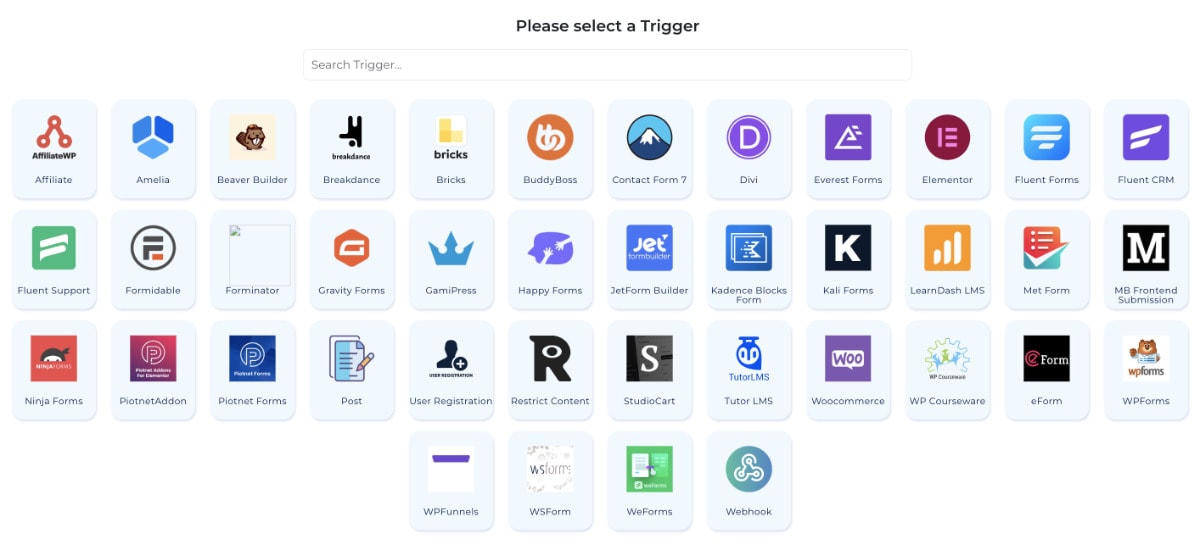
Pros ✅
- Send data wherever you want, whenever you want for free.
- Not reliant on third-party services
- Conditional logic tools inside the WordPress ecosystem
- Webhooks included
Cons ❌
- Resource-intensive and may slow down your website.
- Not suitable for large organizations
Thrive Automator
Thrive Automator is a free plugin for WordPress with many features that rival some of the paid options in this list. Sign up for a free Thrive Themes account to get access to 20+ integrations that can further improve your workflow. Get Email integrations, WooCommerce events, and more triggers and actions at no cost. You'll need to download and install the Thrive Product Manager to do this. It's a bit of an annoyance, but it's a one-off job that won't take more than a couple of minutes.
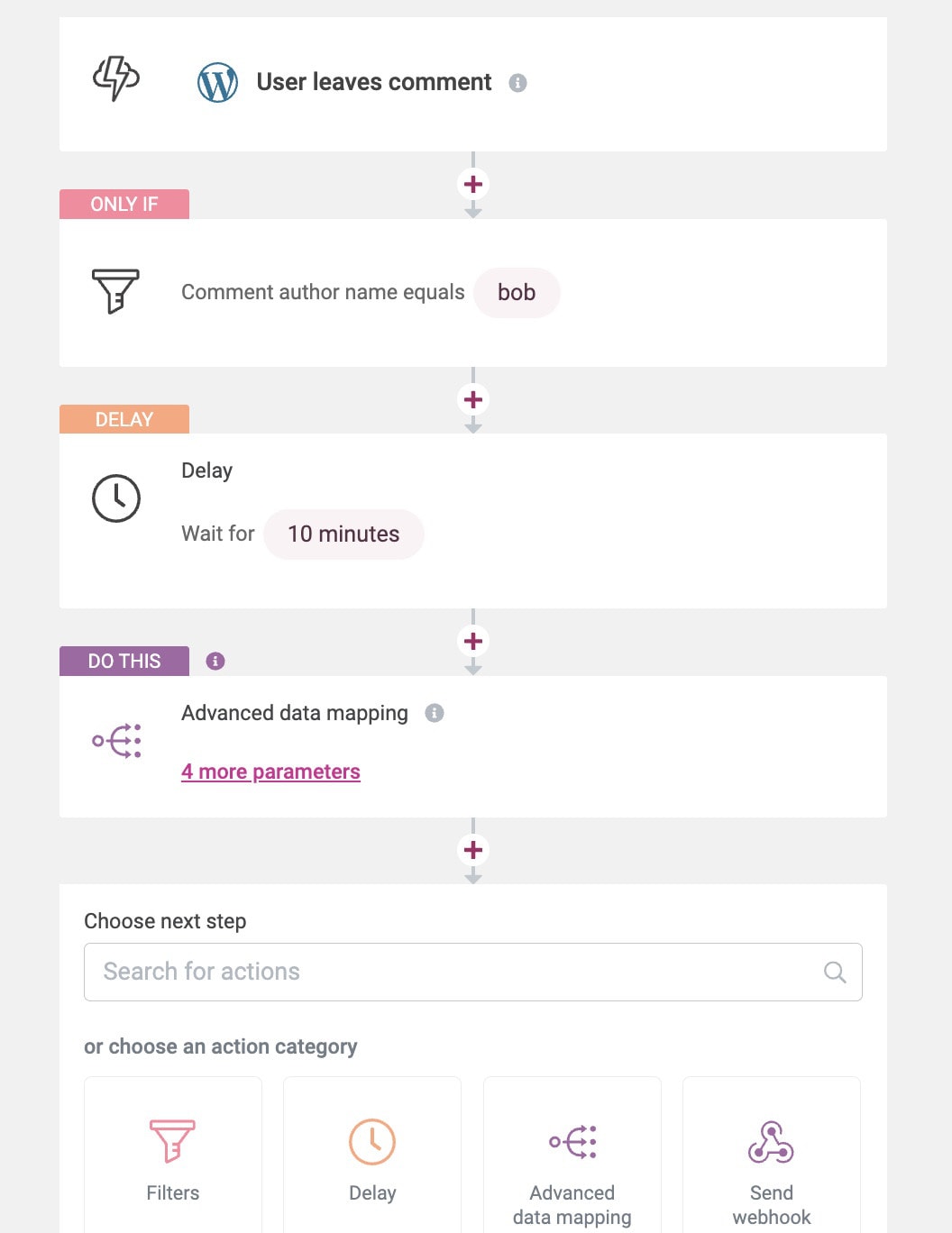
Thrive Automator's trigger options include:
- Webhooks -standard for most of these apps these days)
- General – select a time and date trigger
- Thrive Suite – connect to the suite of tools offered by Thrive like the lead generator forms, website page builder, A/B testing suite, Quiz Builder, and comments plugin
- WordPress – trigger an action when a user leaves a comment, a post is published, users log into their accounts, and more.
You can connect to dozens of applications like Google Drive, Mailgun, SendOwl, Amazon SES, MailPoet, ActiveCampaign, and Facebook.
There are filters to fine-tune the trigger, set delays for the trigger to process, perform advanced data mapping, and finally choose actions to perform. It's a powerful tool that's completely free and available to you as long as you're using WordPress.
WP Webhooks
With WP Webhooks you can automate your workflow within WordPress without writing a single line of code. Automate everything and code nothing—all within WordPress.The plugin is fully integrated with many third-party tools and allows you to automate any action within WordPress without writing a single line of code. This includes creating new posts, updating existing ones, deleting content, or even sending emails.
Automate everything from posting on social media to setting up new users on your WordPress site. You can even build and automate workflows that connect all the apps in your company—from payment processors to HR software
WP Webhooks uses the concept of Flows, which are like Zaps in Zapier, Workflows in Pabbly, or Scenarios in Make. Flows consist of triggers and actions.
A trigger is anything that happens on your WordPress website. Here are some examples:
- a new user is added
- a new post is published
- a new order is created in WooCommerce
- a new course is completed in LearnDash.
Actions are events that happen once a trigger is activated. Examples:
- find and replace text
- create a new WordPress post
- send a request to software tools that can receive webhooks.
You can integrate with n8n, Zapier, Make, and many other workflow autiomation platforms so this doesn't have to be an exclusive arrangement. But unlike Zapier, you won't pay for the volume of actions you perform with WP Webhooks. It's worth looking at your Zaps to see which ones you could offload to WP Webhooks. It's cheaper, faster, and more customizable compared to Zapier to keep it all in-house.
Power Automate
Microsoft Power Automate (previously called Microsoft Flow) is automation platform for automating your repetitive tasks with intuitive drag-and-drop tools and a plethora of popular app connectors.
Power Automate takes efficiency to the next level by offering up recommendations about what workflow automations to build with the business process advisor.
One notable feature of Power Automate is the integrated AI builder that’s capable of processing forms and approvals with document automation. It can also detect text and images.
Power Automate is available in 3 versions: a desktop app, a web-based app, and a mobile app. You can also bundle it up with Microsoft Teams, so you can work efficiently with your teammates.
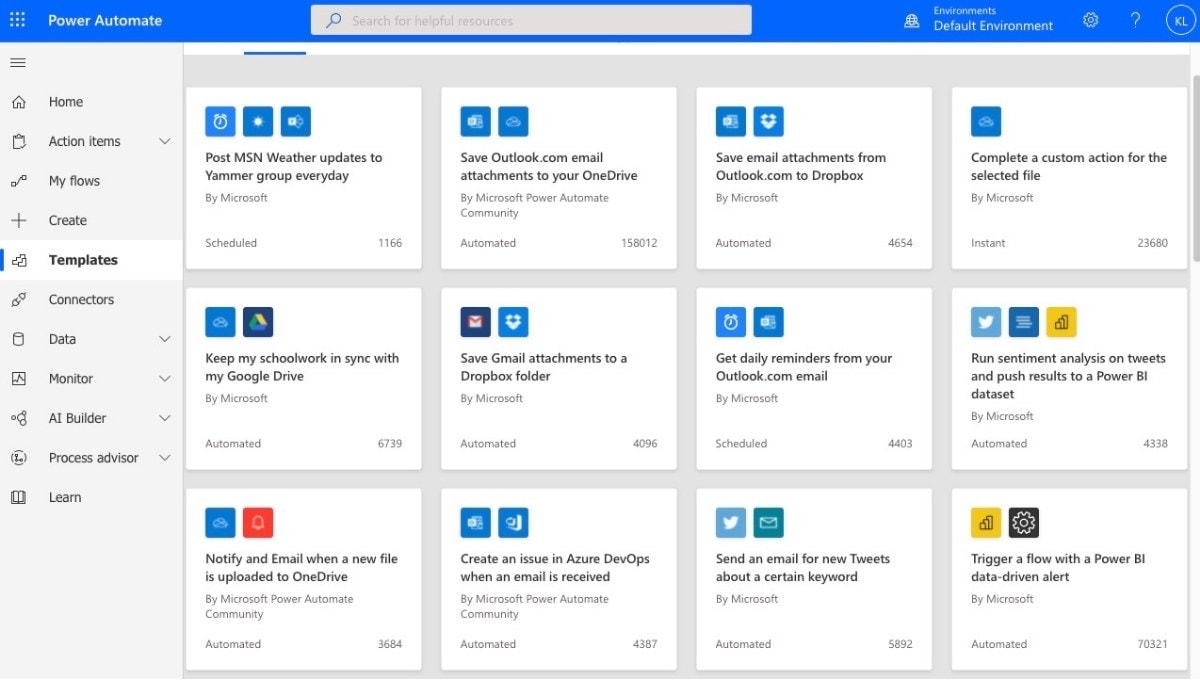
Some of the available Power Automate templates include sending customized emails after a new file is added, email reminders, and copying files as PDFs in OneDrive.
Microsoft offers 3 pricing plans for its automation tool: $15/month, $40/month, and $500/month. The cheaper plans are licensed by the user while the remaining one is licensed by Flow.
With Microsoft Power Automate, you can have a personal robot minion to do your repetitive tasks for you. Automate your workflows using AI and desktop software to save time. The Robotic Process Automation tool integrates with many different apps and services through pre-built or customizable connectors. It's also possible to build your own connectors, so there's no limit to the types of tasks you can hand off to automate processes.
It's time to say goodbye to computer-based grunt work and hello to automated workflows.
Microsoft Flow is a great automation solution for those who are heavily invested in Microsoft’s ecosystem and want native integration workflows. If you use software like Outlook, Microsoft Azure, Excel Online, Word Online, and Powerpoint, and want the convenience of numerous templates, this is one of the best Zapier alternatives and fully-featured automation platforms.
Pros ✅
- Integrated AI builder
- Offers Robotic Process Automation (RPA)
- Works seamlessly with Microsoft apps
- Process advisor helps you create more efficient automations for your business
- Easy to use
Cons ❌
- Very dependent on Microsoft’s apps
- Not the most user-friendly business process automation tool
- “Only” 400 connectors
- The free plan is quite limited
IFTTT
IFTTT, or “If This Then That”, is a well-rounded tool that connects the dots between many popular “everyday” services like Gmail, Google Assistant, FitBit, iOS photos, Siri, weather apps, and Google Sheets. I like to think of it as a quick-and-dirty automation tool for consumer apps. However, IFTTT is capable of connecting business tools and apps and can compete with Zapier in a number of areas.
But why is it a good alternative to Zapier? Well, it’s mostly about the areas of focus of each tool. IFTTT is one of the few automation tools out there that emphasize creating workflows by connecting digital voice assistants like Cortana and Siri. It also works with smart home devices like Arlo Pro 4 and Amazon Echo Studio.
On the other hand, Zapier is more focused on Enterprise solutions by connecting software like SQL Server, Amazon S3, and GoToWebinar. IFTTT supports Facebook, Instagram, Slack, and many other app integrations, so it’s not just limited to voice assistants and smart home devices.
Another area where IFTTT has the upper hand over Zapier is that it offers iOS and Android mobile apps, while Zapier is limited to desktops only.
The service was historically free to use but in recent years, the company has offered paid plans (one minor gripe is the constant nagging to upgrade). IFTTT's Pro plan Introducing IFTTT Pro – IFTTT includes multi-step Applets (Applets are like Zapier's zaps), queries and conditional logic, multiple actions, and faster Applet execution times.
IFTT is an effective tool for personal organization. It enables users to generate “automation recipes” from simple “If this happens, then do this” instructions, for example: following back targeted followers, tracking mentions on social media, or logging links on your favorite subreddits and saving them in a Google Sheet document.
Small business owners that use apps like Notion, Todoist, Amazon Alexa, TickTick, Google Calendar, Dropbox, and other popular business apps will find plenty of Applets that help save time.
Pros ✅
- Works with digital voice assistants
- Supports smart home devices
- Has a free plan
- Supports multi-step automation on paid plans
- Has a mobile app (unique among automation platforms)
Cons ❌
- Limited organizational tools & customizability
- Notoriously buggy – probably not the best option for mission-critical automations
- Creating new applets is complicated
How to Choose the Right Zapier Alternative for Your Professional Needs
The following are some ways you can decide if an automation tool is right for you:
User Interface
A workflow automation tool's whole purpose is to automate tasks without any coding or technical knowledge. User interfaces that are cluttered and difficult to use defeat the purpose of using automation tools. You want the tool's interface to be intuitive and require little to no technical knowledge.
App Integrations
Consider the number and type of apps it can integrate before choosing a workflow automation tool. This will be determined by your industry niche, the most commonly used apps in your niche, and the specialization.
Price
There may be Zapier alternatives that are free, cheaper, or more expensive, so it all depends on your budget, the size of your business, and what you need automated. It makes more sense to use a free or budget tool if you're an individual or run a small business. Saving on monthly expenses is one of the most common reasons people look for Zapier alternatives.
Which to choose?
Most users will probably find n8n.io to be an excellent choice. It has all the bells and whistles you could want in an automation tool, including a self-hosting option. WP Fusion is the most powerful for deep integrations and custom integrations with WordPress.
On the flip side, if you’re looking for an automation tool that’s designed specifically for digital voice assistants and smart home devices, IFTTT is a good option for you.
Finally, consider subscribing to Pabbly Connect for the best tradeoff between value and price.

